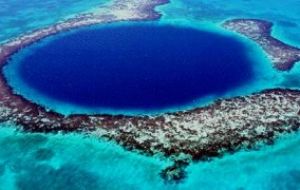MercoPress. South Atlantic News Agency
Prolonged extreme droughts could help to explain collapse of Mayan civilization
 A team headed by Rice University professor Andre Droxler analyzed sediment found in the Blue Hole, a 410-foot-deep sinkhole in Belize’s Lighthouse Reef.
A team headed by Rice University professor Andre Droxler analyzed sediment found in the Blue Hole, a 410-foot-deep sinkhole in Belize’s Lighthouse Reef.  The chemical composition of the sediment indicated periods of sparse rainfall during the Mayan decline, thought likely between AD800 and AD1000.
The chemical composition of the sediment indicated periods of sparse rainfall during the Mayan decline, thought likely between AD800 and AD1000. The mysterious collapse of the ancient Mayan civilization has been attributed to a variety of factors, most notably overhunting, deforestation, and a catastrophic peasant uprising. However the theory of prolonged extreme drought has been gaining ground among the scientific community in recent years regarding the Mayan demise.
Now, further evidence has emerged to support the drought postulation, with the proof possibly to be found in Belize’s most famous underwater cave “The Great Blue Hole.”
According to a report in LiveScience, a team headed by Rice University professor Andre Droxler analysed sediment found in the Blue Hole, a 410-foot-deep sinkhole in the middle of Belize’s Lighthouse Reef.
The chemical composition of the sediment indicated periods of sparse rainfall during the Mayan decline, thought likely between AD800 and AD1000.
The silt also showed that a second major drought probably followed between AD1000 and AD1100, coinciding with the timing of the reputed fall of the Mayans’ relocation site of Chichen Itza.
Over thousands of years, runoff from rivers and streams during periods of abundant rainfall deposited layers of sediment in the Blue Hole’s lagoon, presenting scientists with a geological timeline to examine.
“It’s like a big bucket. It’s a sediment trap,” Droxler told LiveScience with reference to the Blue Hole.
Heavy rain also erodes volcanic rock, which contains titanium. Droxler’s team found that the mineral composition of the sediment in the lagoon, specifically the low ratio of titanium to aluminum, indicated periods of low rainfall during the times when the Mayas, for the most part, disappeared.
Experts surmise that monsoons may have skipped over the Yucatan Peninsula during these periods, leading to eventual catastrophe.
“When you have major droughts, you start to get famines and unrest,” Droxler indicated.




Top Comments
Disclaimer & comment rules-

Read all comments“When you have major droughts, you start to get famines and unrest,” Droxler indicated.
Jan 05th, 2015 - 07:08 am 0And conversely high rainfall and flood conditions, which was theorized 17 years ago.
Both can seriously affect the food supply.
Commenting for this story is now closed.
If you have a Facebook account, become a fan and comment on our Facebook Page!